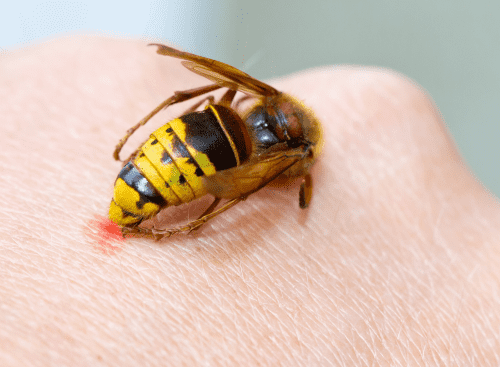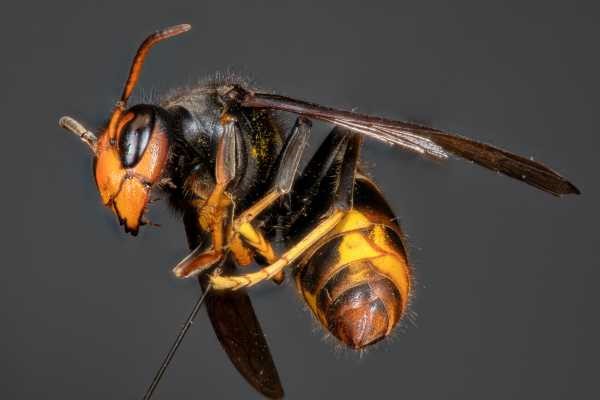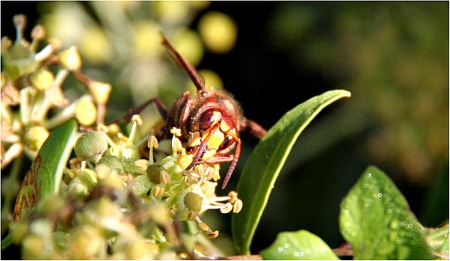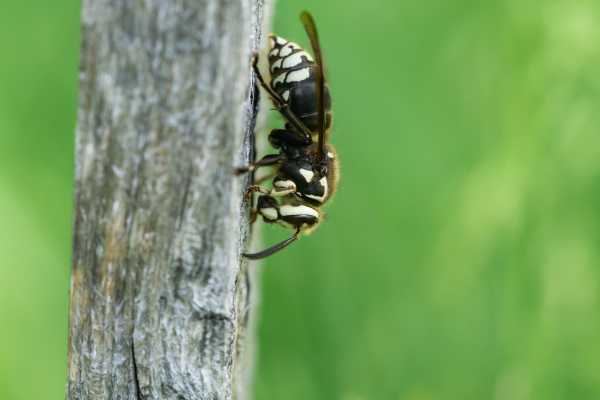How Do Honey Bees Defend Themselves Against Hornets?
Hornets
are pollinators and are fascinating insects, but they are no friend of the
honey bee. Here, we'll take a look at the fascinating methods honey bees use to defend themselves against this dangerous enemy of bees.
4 Reasons Why Hornets Are No Friend To The Honey Bee
1. Hornets eat bees
Hornets are social (actually eusocial) and live in colonies of several hundred
individuals, but unlike bees, they don’t rely on nectar and pollen for rearing
their young. Instead, hornets feed their
own young with other insects and their larvae.
Thus a honey bee colony of several thousand bees provides a lot of food for hungry hornets and their young.
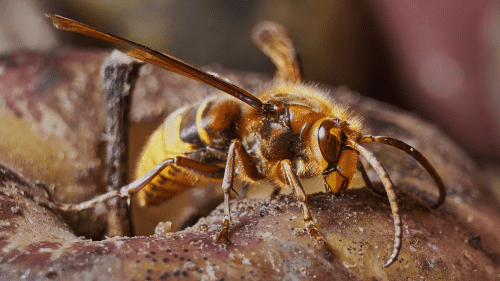 European hornet - Vespa crabro
European hornet - Vespa crabro2. A sting that is deadly for bees
A hornet has a venomous sting, that is larger in size than the sting of a honey bee. As an example, the European hornet, Vespa crabro, has a sting length of 5.39 mm, which is almost twice the size of the sting of the honey bee Apis mellifera, measuring just 2.99 mm.
3. Strong body armoury
Hornets have a tough chitin exoskeleton to protect themselves against stings from bees, making it difficult for bees to defend themselves.
4. Fearsome jaws
Whilst bees do have their version of teeth (mandibles), the jaws of hornets are larger and designed for crushing and biting their target prey.
These factors combined mean that hornets are a deadly predator and a major threat to bees.
During mass attacks on hives, hornets can literally kill thousands of bees within a few hours. Yes in some regions of the world, honey bee have evolved innovative means to deal with hornets (we'll come to that in a moment).
How
do hornets hunt and kill bees?
Hornets employ a range of tactics in their attacks on honey bees.
In general, individual hornets may pick off single bees, or several hornets may embark on a full scale attack on the colony.
Single hornet attacks
Single hornets may attack bees by hunting them from the
air, or ambushing bees whilst foraging. They may also target bees as they leave, approach or land at the nest entrance.
After catching a bee, the hornet flies off to a suitable perch where it can rest and manipulate the prey, biting off the head and sometimes other body parts (wings and legs), before flying off with the partially chewed, dismembered bee, back to its own nest where the carcass of the bee will be fed to the developing hornet larvae.
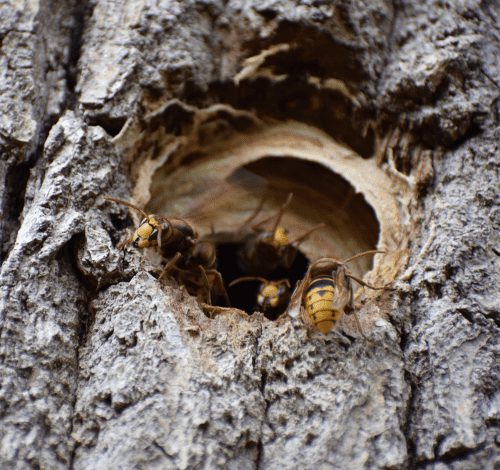 European hornet - Vespa crabro nest in tree hollow
European hornet - Vespa crabro nest in tree hollowMass hornet attacks
Some hornet species are known for deadly mass attacks on nests or hives, killing many bees and destroying colonies.
Vespa mandarinia (Asian giant hornet, also known as the 'Murder hornet') and Vespa soror (the Giant hornet) are two species especially known for such attacks.
When a single Vespa mandarinia or Vespa soror scout hornet locates a honey bee nest or hive, it chemically marks it by rubbing its abdomen on the surface, and then recruits fellow colony members to the site. To gain easier access to the hive or nest, they chew at the entrance, and kill any defending worker guard bees.
A group of 50 hornets can kill thousands of bees within a few hours, the surviving honey bees sometimes absconding from the hive.
The hornets then take up occupation of the nest, all the time guarding it whilst they begin a process of removing dead bees and larvae which the hornets carry back to their own nests to feed their offspring.
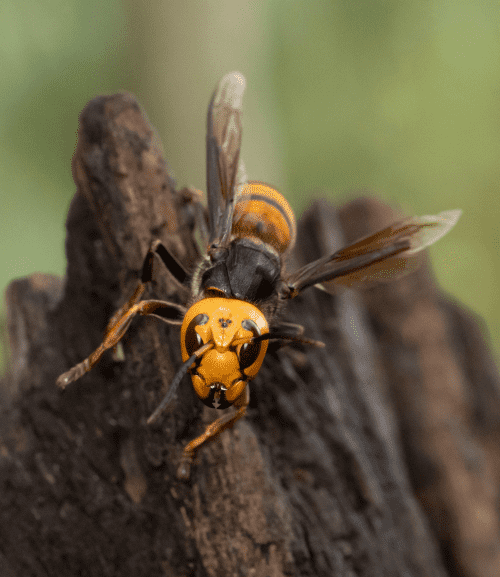 Asian giant hornet, also known as the Murder hornet - Vespa mandarinia
Asian giant hornet, also known as the Murder hornet - Vespa mandarinia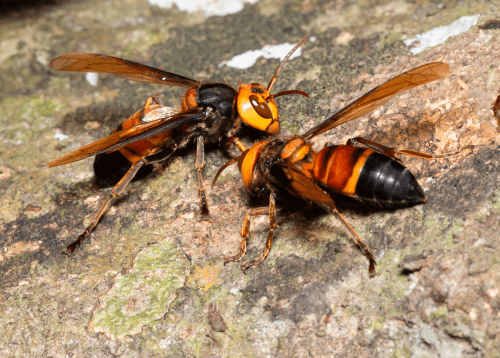 Giant hornets- Vespa soror
Giant hornets- Vespa sororCan Bees Kill Hornets?
How Honey Bees Defend Their Nests And Hives Against Hornets
Honey bees have developed a number of ways to defend themselves against hornets, including physical, chemical and behavioural barriers, which combined are known as 'defence portfolios'.
However, defence strategies of different honey bee species vary, and appear to have adapted in response to the prevalence and severity of threat from local hornet species.
Scientists found that the European honey bee (also known as the Western honey bee, Apis mellifera) that were introduced to Oriental regions, are unable to defend their colonies against attacks by the aggressive Asian giant hornet (or 'Murder hornet'), Vespa mandarinia.
Hissing, shimmering
A number of honey bee species make high pitched noises to alert other colony
members and ward off threats.
Alarm pheromone
Bees may emit an alarm pheromone to warn nestmates of impending threat of
hornets, and stimulate various defensive reactions, which may include some of
the behaviours described below.
Forming a barrier, defensive wave
Bees may form a barrier of many bees at the nest entrance, in an effort to
prevent entry by hornets. Interestingly, the honey bee Apis cerana has been observed to use animal poop as a deterrent to Asian giant hornet attacks.
Overheating and suffocating
A number of honey bee species kill individual hornets by ‘balling’ the
hornets. In doing so, the hornet is
killed by overheating, and possibly also by asphyxiation and multiple stings,
and perhaps a combination of these.
Defensive bee balling is particularly pronounced in the Asian honey bees, Apis cerana which have to contend with the deadly Asian giant hornet (Murder hornets) Vespa mandarinia or the Giant hornet, Vespa soror.
Video: Watch honey bees heat balling a hornet, roasting the attacking hornet to death
The video below is about 5 minutes long, and worth watching. The honey bees native to Japan (Apis cerana) have evolved the 'heat-balling' method to perfection.
European honey bees (or 'Western honey bee' - Apis mellifera) transported to Japan, are not so effective in their defenses against this dangerous predator.
Below is a table summarizing several research investigations, describing defence portfolios of different honey bee species against attacking hornets.
| Honey Bee Species | Hornet Species | Method Of Defence | Research |
|---|---|---|---|
| Apis nuluensis | Vespa multimaculata | Guard bees balled and killed individual hornets with heat. | Koeniger et al 1996 |
| Apis cerana, Apis mellifera | Vespa velutina (Asian hornet) | Formed heat balls around individual hornets. There were significantly more worker bees in Apis cerana heat balls, with higher temperature achieved than for those of Apis mellifera. | Ken et al 2005 |
| Apis mellifera ligustica | Vespa crabro (European hornet) | Form packed aggregations of bees near hive opening, which may deter hornet from entering. Bees cling together in groups, knock down approaching hornets then balled them, resulting in overheating and asphyxia. | Barrachi et al 2010 |
| Apis cerana | Vespa mandarinia (Asian giant hornet, or 'Murder hornet') | Produce vibratory signals and release alarm pheromone to communicate threat at the nest entrance, and stimulate nestmates to prepare to “heat ball” scouting hornets. Smearing of plant-based materials around nest entrances, possibly interfering with pheromones deposited by hornet scouts. | McClenaghan et al 2019 Fujiwara et al 2016 |
| Apis cerana | Vespa soror (Giant hornet) | Use animal poop to deter hornets from nest entrance. Heat balling of individual hornets. | Mattila et al 2020 |
References
- MATSUURA & YAMANE 1990) MATSUURA M. & YAMANE S.K. 1990. Biology of the Vespine wasps. Berlin: Springer.
- Papachristoforou A, Rortais A, Zafeiridou G, Theophilidis G, Garnery L, Thrasyvoulou A, et al. Smothered to death: hornets asphyxiated by honeybees. Curr Biol. 2007;17: R795–R796. pmid:17878045.
- Barrachi D, Cusseau G, Pradella D, Turillazzi S. Defence reactions of Apis mellifera ligustica against attacks from the European hornet Vespa crabro. Ethol Ecol Evol. 2010;22: 281–294.
- Apis nuluensi guard bees balled and killed the hornet V multimaculata with heat Koeniger N, Koeniger G, Gries M, Tingek S, Kelitu A. Observations on colony defense of Apis nuluensis Tingek, Koeniger and Koeniger, 1996 and predatory behavior of the hornet, Vespa multimaculata Pérez, 1910. Apidologie. 1996;27: 341–352.
- Ken T, Hepburn HR, Radloff SE, Yusheng Y, Yiqiu L, Danyin Z, Neumann P. Heat-balling wasps by honeybees. Naturwissenschaften. 2005 Oct;92(10):492-5. doi: 10.1007/s00114-005-0026-5. Epub 2005 Oct 28. PMID: 16151794.
- Sadler EA, Pitts JP, Wilson JS. Stinging wasps (Hymenoptera: Aculeata), which species have the longest sting? PeerJ. 2018 May 2;6:e4743. doi: 10.7717/peerj.4743. PMID: 29736350; PMCID: PMC5936069.
- Cappa F, Cini A, Bortolotti L, Poidatz J, Cervo R. Hornets and Honey Bees: A Coevolutionary Arms Race between Ancient Adaptations and New Invasive Threats. Insects. 2021;12(11):1037. Published 2021 Nov 18. doi:10.3390/insects12111037.
- McClenaghan B, Schlaf M, Geddes M, Mazza J, Pitman G, McCallum K, et al. Behavioral responses of honey bees, Apis cerana and Apis mellifera, to Vespa mandarinia marking and alarm pheromones. J Apic Res. 2019;58: 141–148.
- Fujiwara A, Sasaki M, Washitani I. A scientific note on hive entrance smearing in Japanese Apis cerana induced by pre-mass attack scouting by the Asian giant hornet Vespa mandarinia. Apidologie. 2016;47: 789–791.
If you found this page helpful or interesting, I'd really be grateful if you would share it with others - if not this page, perhaps another, such as Gardening For Bees.
Thank you so much :) .
